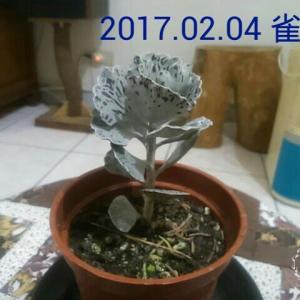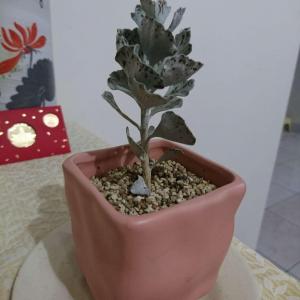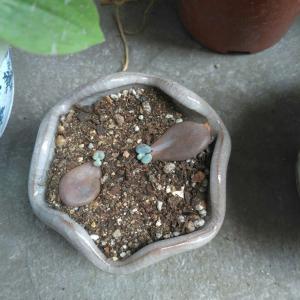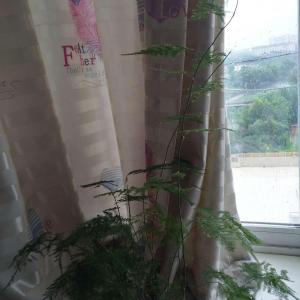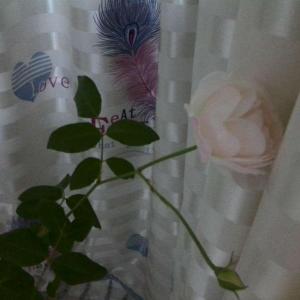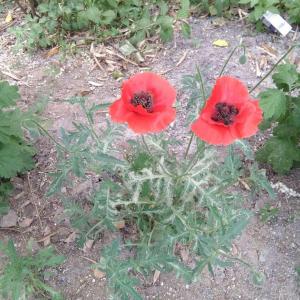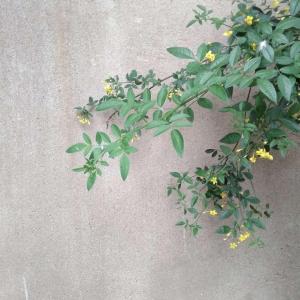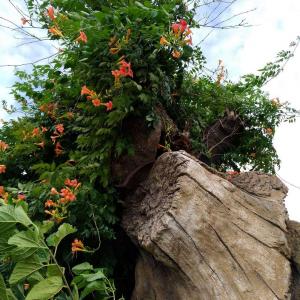文章
Miss Chen
2017年08月05日


Rosales de gran tamaño, ramificaciones muy libres, con ramilletes compuestos en general por 5-7 flores semidobles a dobles.
Las flores nacen en ramilletes en verano.
Follaje muy abundante y lustroso, verde grisáceo.
Son muy resistentes y adecuados para borduras y también para utilizarlos a modo de ejemplares aislados.
0
0
文章
Miss Chen
2017年08月05日


Description: This herbaceous perennial plant forms a rosette of spreading to ascending basal leaves. The basal leaves are up to 12" long and 4" across, although they are usually less than two-thirds of the maximum size; they are simple-pinnate with 5-11 pairs of sessile opposite leaflets and a sessile terminal leaflet. The petioles of basal leaves are relatively stout and more or less long-hairy, especially toward their bases; they are light green, whitish yellow, or red. The leaflets become gradually larger toward the tips of the compound leaves; they are up to 2" long and ¾" across. The leaflets are elliptic-oblong or oblanceolate-oblong in shape and coarsely serrated along their margins; the teeth of the margins have narrow bristly tips. The upper leaflet surface is yellowish green to dark green, glabrous to sparsely hairy, and more or less shiny. The lower leaflet surface is white-canescent from dense minute hairs, and some longer white hairs may be present. Interspersed between these leaflets, there are often much smaller secondary leaflets with similar characteristics.
The rachises of the compound leaves are similar to their petioles, except there are grooved above and tend to be less hairy. From the center of the rosette of basal leaves, one or more widely spreading stolons are produced that are 1-3' long. At intervals along these stolons, there are leafy-bracted nodes about 4-6" apart. The stolons are red, terete, and glabrous to sparsely long-hairy. The leafy bracts of the nodes are simple-pinnate; they resemble the basal leaves, except they are much smaller in size (up to 4" long and 1" across). When the nodes have contact with moist ground, they are able to develop new roots, from which new rosettes of basal leaves can develop. Solitary flowers are produced from the nodes of the stolons on long naked pedicels (floral stalks) about 2-6" long. These ascending to erect pedicels are light green to red, terete, and nearly glabrous to long-hairy. Each flower spans about ¾" across, consisting of 5 spreading yellow petals, 5 light green sepals, a ring of 20-25 yellow stamens, and a central head of 20-100+ yellow pistils. The petals are obovate or broadly elliptic in shape, while the hairy sepals are ovate, and often cuspidate (abruptly tapering into narrow pointed tips).
Directly underneath the sepals, there are 5 floral bractlets; these bractlets are similar to the sepals, except they are usually lanceolate and sometimes sparingly toothed. Both the sepals and bractlets are joined together at the base, and they are both shorter than the petals. The blooming period occurs during the summer and early autumn for 2-3 months. Flowering is more abundant during periods of active growth. Cross-pollination of the flowers is required for the production of fertile seeds. The seedheads are cupped along their sides by the persistent sepals and floral bractlets. Individual seeds are 2–2.5 mm. long, compressed-ovoid in shape, and grooved along the upper surface. Because the outer seed coat is somewhat corky from enclosed air pores, the seeds are able to float on water; they can also be blown about by the wind. The primary root system consists of a taproot that often branches. This plant forms clonal colonies by means of its stolons.
Cultivation: The preference is full sun, wet to mesic conditions, and calcareous soil containing gravel or sand. This plant doesn't tolerate much competition from taller vegetation.
Range & Habitat: The native Silverweed is uncommon in NE Illinois, while in the rest of the state it is absent (see Distribution Map). Silverweed has a wide distribution in boreal areas of North America, and it also occurs in Eurasia. Habitats include sand prairies, moist sand flats (pannes), borders of interdunal swales, low areas along sandy ponds, small sand dunes, middle to upper beach areas, and gravelly or sandy areas along mowed paths. In Illinois, this plant occurs primarily along Lake Michigan. It is usually found in high quality habitats where there is some natural disturbance from water or wind, although it can also colonize open degraded areas that are moist, sandy, or gravelly. This is one of the pioneer plant species that helps to stabilize the sand in wetlands, low dunes, and beach areas.
Faunal Associations: The flowers are usually cross-pollinated by various bees and flies, including bumblebees, cuckoo bees (Stelis spp.), Andrenid bees, and Syrphid flies (Miyanishi et al., 1991; Krombein et al., 1979; Discover Life, 2015). Both nectar and pollen are available as floral rewards. A small number of insects have been reported to feed on the foliage, sap, or roots of Silverweed in North America. These species include a flea beetle (Altica browni) and several aphids (Chaetosiphon fragaefolii, Macrosiphum potentillae, and Rhopalosiphoninus latisiphon); see Clark et al, (2004) and Blackman & Eastop (2013). Foliage and flowers of Silverweed are occasionally browsed by White-tailed Deer and other hoofed mammalian herbivores, although they are not eaten by the granivorous American Bison. By surviving the passage through their digestive tracts, the seeds of this plant may be spread to new locations by these mammals.
Photographic Location: A moist gravelly area along a path and a low area along a sandy pond at Illinois Beach State Park in NE Illinois.
Comments: A scientific synonym of Silverweed is Potentilla anserina. The description of this plant refers to the typical subspecies, Argentina anserina anserina. This is the only subspecies that occurs in Illinois. Other subspecies have been described that vary in such characteristics as the hairiness of the foliage, the general size of individual plants, the presence or absence of an upper groove on the seeds, the relative size of the sepals versus the floral bractlets, and other characteristics. It is relatively easy to distinguish Silverweed from similar species (mainly Potentilla spp.). Compared to these other species, Silverweed can be distinguished by the greater number of leaflets per compound leaf, brilliant white undersides on its leaflets, sharp bristly teeth along the margins of its leaflets, and conspicuous red stolons.

0
0
文章
Miss Chen
2017年08月05日


Description: This herbaceous perennial plant becomes about 2½–5' tall at maturity. Initially, this plant develops an erect central stem with opposite leaves during the late spring, but during early to mid-summer it branches abundantly. The stems are light green to red, terete, glabrous, and sometimes glaucous. At intervals along these stems, there are pairs of opposite leaves. These leaves are 1½–3½" long and about one-third as much across; they are broadly elliptic to broadly elliptic-oblong in shape and smooth (entire) along their margins. The upper leaf surface is medium green or yellowish green and glabrous, while the lower leaf surface is light green, glabrous, and sometimes glaucous. Leaf venation is pinnate. When petioles are present, they are up to ¼" long, light green, and glabrous; otherwise, the leaves are sessile. Plants with sessile leaves are sometimes referred to as Apocynum sibericum. The stems and leaves contain a milky latex that is bitter-tasting and toxic. The upper stems and some lateral stems terminate in panicles of flowers spanning 1–3" across; these panicles are flat-headed to dome-shaped.
Each small flower is about 2-3 mm. across and 3-5 mm. long, consisting of 5 white petals, a light green calyx, 5 stamens, and a pistil. The petals are ovate to oval in shape and they are erect to slightly spreading; the calyx is glabrous and it has 5 triangular teeth. The branches and pedicels of the panicles are light green or light yellowish green, terete, and glabrous; individual pedicels are 2-6 mm. long. The blooming period usually occurs during the summer for about 1 month. The flowers are sweetly fragrant. Afterwards, cross-pollinated flowers are replaced by pairs of follicles (seedpods that open along one side). Mature follicles are 4-8" long, narrowly cylindrical in shape, and dark brown. These follicles eventually split open to release their seeds to the wind. Individual seeds are 4-6 mm. long, linear in shape, and brown; they have tufts of white hair at their apices that help to carry them aloft. The root system is long-rhizomatous, often producing clonal colonies of plants.
Cultivation: The preference is full sun and wet to mesic conditions. This weedy plant adapts to mildly acidic to alkaline soil containing loam, clay-loam, or clay-gravel. It readily tolerates flooded conditions during the spring, while tolerating drought later in the year. By late summer, the lower leaves of this plant turn yellow and begin to fall off as its condition steadily deteriorates. In moist open areas, clonal colonies can spread aggressively from underground rhizomes.
Range & Habitat: The native Common Dogbane occurs in every county of Illinois, where it is quite common (see Distribution Map). Habitats include wet prairies, prairie swales, soggy thickets, moist meadows along rivers, edges of swamps, seasonal wetlands in open areas, abandoned fields, poorly drained areas along fence rows, poorly drained areas in vacant lots, poorly drained areas in junkyards, roadside ditches, and gravelly depressions along railroads. Common Dogbane is usually found in degraded wetlands that have a history of disturbance. It is a pioneer species of such habitats.
Faunal Associations: The abundant nectar of the flowers attracts many kinds of insects, including cuckoo bees (Nomada spp.), Halictid bees, plasterer bees (Colletes spp.), masked bees (Hylaeus spp.), Sphecid wasps, Syrphid flies, bee flies (Bombyliidae), Tachinid flies, Calliphorid flies, butterflies, skippers, and beetles (Robertson, 1929). These insects vary in how effectively they cross-pollinate the flowers. The larvae of several moths feed on Common Dogbane, including the Delicate Cycnia (Cycnia tenera), Oregon Cycnia (Cycnia oregonensis), Six-spotted Gray (Spargaloma sexpunctata), and a Gracillariid moth (Marmara apocynella); see Wagner (2005), Covell (1984/2005), and Needham et al. (1928). Larvae of the last moth bore through the stems of this plant. Other insect feeders include larvae and adults of the Dogbane Beetle (Chrysochus auratus), larvae of the Red Milkweed Beetle (Tetraopes tetrophthalmus), larvae of the Dogbane Flower Midge (Clinodiplosis apocyni), the Large Milkweed Bug (Oncopeltus fasciatus), and an aphid (Aphis asclepiadis); see Clark et al. (2004), Yanega (1996), Felt (1917), Hoffman (1996), and Hottes & Frison (1931). Mammalian herbivores usually avoid the consumption of Common Dogbane because the bitter foliage contains cardiac glycosides and other toxic compounds.
Photographic Location: A fence row near Urbana, Illinois, and a remnant prairie along a railroad in Savoy, Illinois.
Comments: Another common name for this plant is Indian Hemp, because native Amerindians obtained strong silky fibers from the stems. These fibers were used as twine in basketry, mats, netting, rope, and other artifacts. Some early French explorers remarked upon the abundance of this plant in the original prairie, which they referred to as 'hemp' in their writings. Common Dogbane (Apocynum cannabinum) can be distinguished from a similar species, Spreading Dogbane (Apocynum androsaemifolium), by its smaller flowers with more erect petals. The flowers are Spreading Dogbane are about 6-8 mm. long and similarly across; their petals are ascending, rather than erect, and the tips of their petals are recurved, rather than straight. Unlike Common Dogbane, Spreading Dogbane is typically found in upland habitats where the soil is more sandy and/or acidic.

0
0
文章
Miss Chen
2017年08月05日


Description: This herbaceous perennial plant is about 1-2' tall. The basal leaves occur in whorls from long stalks that emerge out of the ground. They are divided into 3-5 lobes and have dentate margins. From each whorl of the basal leaves often emerges a second whorl of leaves. These secondary leaves are smaller than the basal leaves, but otherwise similar in form. From each whorl of the secondary leaves emerges a long stalk bearing a single white flower. In less mature plants, sometimes the basal leaves produce flowering stalks, rather than whorls of secondary leaves. Sometimes there are small alternate leaves sparsely distributed along the flowering stalks, but they are more narrow and less lobed than the whorled lower leaves. There are scattered white hairs on both the leaves and their stalks. Each flower is about ¾" across, and has 5 petal-like sepals that often fail to open fully. In the center, is a small green cone that is surrounded by numerous stamens with yellow anthers. As the flower withers, the green cone develops into an elongated fruit that resembles a cylindrical green thimble up to 1½" long, hence the name of the plant. This thimble is at least twice as long as it is wide.
The blooming period occurs from early to mid-summer and lasts about a month. There is no floral scent. The thimble-like fruits develop during the summer, and then become transformed into cottony tufts during the fall. These cottony tufts contain scattered dark seeds and persist during the winter. The seeds are distributed by the wind. The root system consists of a taproot and tough slender rhizomes, which can form vegetative offsets. This plant produces an allelopathic substance, protoanemonin, which inhibits seed germination and seedling growth of many species of plants.
Cultivation: The preference is full to partial sun, and mesic to dry conditions in a rather sandy or gritty soil. In rich fertile soil, this plant has trouble competing with taller, more aggressive plants. Thimbleweed is often temperamental about being transplanted and difficult to start from seed; transplantation should occur during the spring after danger of hard frost has passed. Established plants, however, are reliable and easy to deal with. Foliar disease is rarely a problem.
Range & Habitat: The native Thimbleweed occurs occasionally in northern Illinois, it is scattered and uncommon in central Illinois, and rare or absent in southern Illinois (see Distribution Map). Habitats include dry upland areas of black soil prairies, loess hill prairies, scrubby barrens, limestone glades, sandy Black Oak savannas, open sandy woodlands, abandoned fields, and open areas along roadsides. This plant is usually found in less disturbed habitats.
Faunal Associations: The abundant pollen of the flowers attract small bees and Syrphid flies. The bee visitors include Plasterer bees and Halictid bees. Mammalian herbivores usually avoid consumption of this plant because the foliage is toxic, causing a burning sensation in the mouth and irritation of the gastrointestinal tract.
Photographic Location: The photographs were taken at the webmaster's wildflower garden in Urbana, Illinois.
Comments: This unusual plant has attractive thimble-shaped seedheads that later look like white tufts of cotton; otherwise, its appearance isn't particularly showy. Among the native anemones, Thimbleweed has the greatest fidelity to prairies and the best tolerance of drought (not including the Pasque Flower). It can be distinguished from other anemones by the cylindrical seedheads, which are at least twice as long as they are across. Unlike Anemone canadensis (Canada Anemone), Thimbleweed's leaves have petioles, whereas the leaves of the former are sessile. Thimbleweed's leaves differ from Anemone virginiana (Tall Anemone) by having less dentation along the margins, and some of its leaves are palmate.

0
0
文章
Miss Chen
2017年08月05日


Description: This perennial wildflower produces basal leaves about ½' tall and flowering stems about ¾-2' tall. The basal leaves are 3-6" long and similarly across. Each basal leaf is deeply divided into 3-5 primary lobes that are more or less oblanceolate in shape; each primary lobe is subdivided into 2-3 secondary lobes. In addition to their lobes, the basal leaves have scattered dentate teeth along their margins. The upper blade surface of these leaves is medium to dark green and either hairless or sparsely short-hairy, while the lower blade surface is pale green and sparsely hairy, especially along the veins. The petioles of the basal leaves are about 4-8" long, light green, terete, and hairy. The flowering stems produce pairs of opposite leaves (leafy involucral bracts) in 1-2 tiers. The opposite leaves are similar to the basal leaves, except they are sessile; leaves of the second tier are also smaller in size. The stems are light green, terete, and hairy. Above each tier of opposite leaves, 1-3 flowers are produced from pedicels about 2-4" long. Each flower is 1-1½" across, consisting of 5 white petaloid sepals, a cluster of pistils, and numerous stamens with yellow anthers. The pedicels are light green, terete, and hairy.
The blooming period occurs from late spring to mid-summer for about 1-1½ months. Afterwards, each flower is replaced by a cluster of achenes. The achenes have bodies about 4-6 mm. long and a little less across, while their beaks are 2-6 mm. long; they are also flattened and slightly hairy. The root system is rhizomatous. Vegetative colonies of plants are often produced.
Cultivation: The preference is full or partial sun, moist conditions, and calcareous soil containing loam or gravelly material.
Range & Habitat: The native Meadow Anemone is occasional in northern and central Illinois, while in the southern section of the state it is rare or absent (see Distribution Map). Habitats include moist prairies, sedge meadows, openings in floodplain woodlands, woodland borders, banks of streams, and swampy areas. These habitats can be either sandy or non-sandy. Because of its attractive flowers and foliage, Meadow Anemone is cultivated occasionally in gardens.
Faunal Associations: Floral visitors include small bees (Andrenid, Halictid) that collect pollen and Syrphid flies that feed on pollen. The larvae of a fly, Dasineura anemone, form bud galls on Meadow Anemone. Another insect, Rhizoecus falcifer (Ground Mealybug), feeds on the roots. Because the foliage contains blistering agents that can irritate the gastrointestinal tract, mammalian herbivores usually avoid consumption of this plant.
Photographic Location: The Toledo Botanical Garden in Toledo, Ohio.
Comments: Meadow Anemone is similar in appearance to Thimbleweed (Anemone virginiana) and Candle Anemone (Anemone cylindrica), except that it has larger flowers, sessile opposite leaves, and achenes that are only sparsely hairy, instead of being embedded in a cottony mass of hairs. In addition to these three species, other native species of this genus in Illinois are smaller plants that bloom earlier in the year. Another common name of Anemone canadensis is Canada Anemone.

0
0
文章
Dummer. ゛☀
2017年08月03日

Family - Asteraceae
Stems - To -1m tall, branching in upper 1/2, herbaceous, erect, short pubescent, minutely winged (ribbed) from leaf bases, from rhizomes.
Leaves - Alternate, sessile, linear, 3-5 nerved, entire, slightly scabrous, acute to acuminate, to +/-10cm long, 8-9mm broad, reduced upward by inflorescence, glandular-punctate (use a lens to see).
Inflorescence - Corymbose arrangement of flower heads. Peduncles winged and pubescent to strigose on wing margins.
Involucre - 5mm tall, 2mm in diameter, cylindrical. Phyllaries imbricate, glabrous, yellowish and often with green apices (viewed with a lens you can see a yellow midvein in the green tip), linear, with scarious margins. Innermost phyllaries to 3.1mm long, .6mm broad.
Ray flowers - Fertile. Ligule yellow, to -3mm long, .5mm broad, glabrous. Achene (in flower) white, .5mm long, pubescent. Pappus of capillary bristles.
Disk flowers - 15-20 per flowerhead. Corolla tube to 2mm long, pale yellow, 5-lobed. Lobes yellow, 1.3mm long, acute, glabrous. Stamens 5, adnate 1/2 way up corolla tube. Anthers yellow, connate around style, included, 1.4mm long. Style bifurcate, just exserted beyond corolla lobes. Achene pubescent, .7mm long (in flower). Pappus of capillary bristles to 3.4mm long.
Flowering - August - October.
Habitat - Prairies, fields, railroads.
Origin - Native to U.S.
Other info. - graminifolia means "grass-leaf" and indeed the leaves on this species are thin and long, much like grass blades. This species is most common in the northeastern 1/4 of Missouri but is scattered in counties through the upper 1/2 of the state.
Steyermark gives two varieties for the plant. Variety media (Greene) Harris, is pictured and described above. Variety nuttallii (Greene) Fern., has leaves which are typically pubescent and more broad than the previous variety.
Stems - To -1m tall, branching in upper 1/2, herbaceous, erect, short pubescent, minutely winged (ribbed) from leaf bases, from rhizomes.
Leaves - Alternate, sessile, linear, 3-5 nerved, entire, slightly scabrous, acute to acuminate, to +/-10cm long, 8-9mm broad, reduced upward by inflorescence, glandular-punctate (use a lens to see).

Inflorescence - Corymbose arrangement of flower heads. Peduncles winged and pubescent to strigose on wing margins.
Involucre - 5mm tall, 2mm in diameter, cylindrical. Phyllaries imbricate, glabrous, yellowish and often with green apices (viewed with a lens you can see a yellow midvein in the green tip), linear, with scarious margins. Innermost phyllaries to 3.1mm long, .6mm broad.

Ray flowers - Fertile. Ligule yellow, to -3mm long, .5mm broad, glabrous. Achene (in flower) white, .5mm long, pubescent. Pappus of capillary bristles.
Disk flowers - 15-20 per flowerhead. Corolla tube to 2mm long, pale yellow, 5-lobed. Lobes yellow, 1.3mm long, acute, glabrous. Stamens 5, adnate 1/2 way up corolla tube. Anthers yellow, connate around style, included, 1.4mm long. Style bifurcate, just exserted beyond corolla lobes. Achene pubescent, .7mm long (in flower). Pappus of capillary bristles to 3.4mm long.

Flowering - August - October.
Habitat - Prairies, fields, railroads.
Origin - Native to U.S.
Other info. - graminifolia means "grass-leaf" and indeed the leaves on this species are thin and long, much like grass blades. This species is most common in the northeastern 1/4 of Missouri but is scattered in counties through the upper 1/2 of the state.
Steyermark gives two varieties for the plant. Variety media (Greene) Harris, is pictured and described above. Variety nuttallii (Greene) Fern., has leaves which are typically pubescent and more broad than the previous variety.
0
0
文章
Dummer. ゛☀
2017年08月03日

Family - Juncaceae
Stems - To +20cm tall, erect, herbaceous, cespitose, from fibrous roots, with small bulblets at the base, multiple from the base.
Leaves - Basal leaves many, to +6cm long, 5-9mm broad, glabrous above and below but with long pilose margins, green, entire, acuminate. Cauline leaves with a closed sheath, to 7-8cm long, +/-5mm broad, glabrous but with long-pilose margins (especially at joint with the stem), acuminate, 2-4 per stem. Sheaths glabrous.
Inflorescence - Terminal umbel or panicle of ovoid flower clusters. Clusters to 9mm long, 5-7mm in diameter. Bracts at the base of the peduncles foliaceous, shorter than the peduncles. Peduncles to +2.5cm long, erect to slightly spreading, glabrous. Bracteoles at the base of the flowers white-scarious, glabrous, 3mm long, ovoid-triangular, ciliate-margined, erose, typically 1-3 per flower. Flowers sessile, +/-20 per cluster. Central cluster of the inflorescence often sessile.
Flowers - Sepals and petals 3, similar, green at the base, shiny chestnut-brown and with scarious margins apically, acuminate, to 3mm long, 1mm broad at the base, erect. Stamens 6, opposite the petals and sepals, erect. Filaments green, glabrous, .3mm long. Anthers yellow, 1mm long. Ovary superior, globose-ovoid, green, glabrous, .6mm long, .6mm in diameter in flower, 3-locular. Style 1, -1mm long, glabrous, green. Stigmas 3, +1mm long. Capsules shorter than the perianth, 3-seeded.
Flowering - April - June.
Habitat - Dry upland forests, mesic upland forests in ravines, upland prairies.
Origin - Native to U.S.
Other info. - This species is found in the southern half of Missouri. It is the only species of its genus in the state.
Steyermark listed only one species in the flora, L. bulbosa (A.W. Wood) Smyth. Since that time other species have been reported in the state. The different taxa are now listed as varieties of L. campestris. There are three. See page 480 of "The Flora of Missouri, Volume 1" by Yatskievych for more details on the different varieties.
Stems - To +20cm tall, erect, herbaceous, cespitose, from fibrous roots, with small bulblets at the base, multiple from the base.
Leaves - Basal leaves many, to +6cm long, 5-9mm broad, glabrous above and below but with long pilose margins, green, entire, acuminate. Cauline leaves with a closed sheath, to 7-8cm long, +/-5mm broad, glabrous but with long-pilose margins (especially at joint with the stem), acuminate, 2-4 per stem. Sheaths glabrous.

Inflorescence - Terminal umbel or panicle of ovoid flower clusters. Clusters to 9mm long, 5-7mm in diameter. Bracts at the base of the peduncles foliaceous, shorter than the peduncles. Peduncles to +2.5cm long, erect to slightly spreading, glabrous. Bracteoles at the base of the flowers white-scarious, glabrous, 3mm long, ovoid-triangular, ciliate-margined, erose, typically 1-3 per flower. Flowers sessile, +/-20 per cluster. Central cluster of the inflorescence often sessile.

Flowers - Sepals and petals 3, similar, green at the base, shiny chestnut-brown and with scarious margins apically, acuminate, to 3mm long, 1mm broad at the base, erect. Stamens 6, opposite the petals and sepals, erect. Filaments green, glabrous, .3mm long. Anthers yellow, 1mm long. Ovary superior, globose-ovoid, green, glabrous, .6mm long, .6mm in diameter in flower, 3-locular. Style 1, -1mm long, glabrous, green. Stigmas 3, +1mm long. Capsules shorter than the perianth, 3-seeded.

Flowering - April - June.
Habitat - Dry upland forests, mesic upland forests in ravines, upland prairies.
Origin - Native to U.S.
Other info. - This species is found in the southern half of Missouri. It is the only species of its genus in the state.
Steyermark listed only one species in the flora, L. bulbosa (A.W. Wood) Smyth. Since that time other species have been reported in the state. The different taxa are now listed as varieties of L. campestris. There are three. See page 480 of "The Flora of Missouri, Volume 1" by Yatskievych for more details on the different varieties.
0
0
文章
Dummer. ゛☀
2017年08月03日

Family - Dryopteridaceae
Stems - Rhizomes scaly, horizontal, with fibrous roots, densely reddish-yellow pubescent, 3-4mm in diameter. Scales typically 5-6mm long.
Leaves - From 1-5cm behind the tip of the rhizome, densely clustered, narrowly lanceolate to oblong in outline, to +/-30cm long, 5-6cm broad. Petioles long (+/-15cm), darker brown at the base, greenish apically, with an adaxial groove, when cut transversely 2 vascular bundles are noticeable. Leaves 1-2 pinnate. Pinnae mostly alternate, at right angles to the rachis, typically bipinnatifid, glabrous, serrate.
Inflorescence - Sori originating from the lateral veins on the pinnae, globular, .3mm in diameter. The indusia originating from one side of the sorus, glabrous, small. Typically +/-15 sporangia per sorus.
Flowering - Spores produced April - July.
Habitat - Mesic and bottomland forests, rich soils of slopes, ravine bottoms, streambanks, sinkhole bottoms.
Origin - Native to U.S.
Other info. - This springtime fern can be found throughout Missouri in the habitats mentioned above. It is the only member of its genus in Missouri to not grow from rock ledges or crevices. The plant typically wilts once the daytime temperatures start to really rise but plants can persist until late summer.
Stems - Rhizomes scaly, horizontal, with fibrous roots, densely reddish-yellow pubescent, 3-4mm in diameter. Scales typically 5-6mm long.

Leaves - From 1-5cm behind the tip of the rhizome, densely clustered, narrowly lanceolate to oblong in outline, to +/-30cm long, 5-6cm broad. Petioles long (+/-15cm), darker brown at the base, greenish apically, with an adaxial groove, when cut transversely 2 vascular bundles are noticeable. Leaves 1-2 pinnate. Pinnae mostly alternate, at right angles to the rachis, typically bipinnatifid, glabrous, serrate.

Inflorescence - Sori originating from the lateral veins on the pinnae, globular, .3mm in diameter. The indusia originating from one side of the sorus, glabrous, small. Typically +/-15 sporangia per sorus.

Flowering - Spores produced April - July.
Habitat - Mesic and bottomland forests, rich soils of slopes, ravine bottoms, streambanks, sinkhole bottoms.
Origin - Native to U.S.
Other info. - This springtime fern can be found throughout Missouri in the habitats mentioned above. It is the only member of its genus in Missouri to not grow from rock ledges or crevices. The plant typically wilts once the daytime temperatures start to really rise but plants can persist until late summer.
0
0
文章
Miss Chen
2017年08月03日


- Nombre científico o latino: Astrophytum asterias.
- Nombre común o vulgar: Astrofito.
- Origen: estados de Nuevo León y Tamaulipas (México) y sur de Texas.
- El género Astrophytum es originario de México. Contiene unas 5 ó 6 especies.
- El tallo de esta planta es esférico y achatado y puede alcanzar los 10 cm de diametro con una altura de aproximadamente 5 cm.
- El color es verde grisaceo o gris verdoso.
- Tiene 8 costillas divididas por pequeños surcos profundos.
- Las aréolas se disponen en el centro de las costillas. Prominentes, circulares, blancas y lanosas.
- Flores: amarillas, con el centro rojizo, de 3 cm de largo y hasta 6,5 cm de diámetro. Salen de la parte superior de la planta.
- Las plantas comienzan a ser floríferas cuando poseen un diámetro de en ocasiones, tan solo 2,5 cm.
- Es de crecimiento muy lento y, cómo las demas representantes del género, ésta especie se hibridiza fácilmente.
- Luz: sol, pero un ligero sombreado le favorece.
- Temperaturas: mínimo de 5ºC, aunque puede resistir temperaturas menores.
- Substrato: mezcla estándar añadiendo un 25% de arena gruesa. Conviene que exista caliza en el suelo.
- Riego: poco para evitar la pudrición. Menor que lo normal para cactus.
- Multiplicación: cómo la planta no emite vastagos, la multiplicación debe realizarse necesariamente a través de semillas. Las semillas de Astrophytum suelen tardar unos 5 días a germinar.

0
0
文章
Dummer. ゛☀
2017年08月02日

Family - Orchidaceae
Stems - To +/-50cm tall, erect, herbaceous, simple, single or double from the base, glabrous, with vertical ridges formed by decurrent leaf and bract tissue, green.
Leaves - 2-5 per stem, sessile, sheathing, glabrous, entire, narrowly elliptic-lanceolate, acute at apex, the largest with blades to +/-12cm long, +/-2cm broad, dull green above, slightly more shiny below. The midrib deeply impressed adaxially, expressed abaxially.
Inflorescence - Terminal spike to +/-10cm long (tall). Axis glabrous. Each flower subtended by a lanceolate bract. Bracts shorter or longer than the flowers (depending on the variety), green, glabrous, entire.
Flowers - Sessile, green. Floral tube -1cm long, typically twisted, glabrous. Sepals 3, ovate to orbicular, glabrous, entire, to 4mm long, 3mm broad. The lateral two spreading. Petals yellow-green. The spur to 6mm long, slightly curved, glabrous. Lower lip blunt at the apex to very slightly emarginate, to +/-4mm long, 3mm broad, glabrous, with two small basal projections and a tubercle at the base adaxially. Lateral petals rounded to ovate or obovate, spreading, 3-4mm long and broad, glabrous. Column -2mm long and broad, facing forward. Pollinia 1.3mm long. Pollen white.
Flowering - May - September.
Habitat - Mesic bottoms, mesic prairies.
Origin - Native to U.S.
Other info. - This species can be found scattered throughout Missouri but is relatively uncommon. The plant is fairly easy to identify because of its green flowers, which are spurred and have an undivided lower lip.
P. flava is commonly divided into two varieties. Both these varieties occur in Missouri but may be hard to differentiate. The varieties are differentiated on the basis of bract length on the inflorescence and also number of leaves per plant. The longer-bracted plants, var. herbiola (R. Br.) Luer are more common in Missouri than the shorter-bracted plants, var. flava.
Stems - To +/-50cm tall, erect, herbaceous, simple, single or double from the base, glabrous, with vertical ridges formed by decurrent leaf and bract tissue, green.
Leaves - 2-5 per stem, sessile, sheathing, glabrous, entire, narrowly elliptic-lanceolate, acute at apex, the largest with blades to +/-12cm long, +/-2cm broad, dull green above, slightly more shiny below. The midrib deeply impressed adaxially, expressed abaxially.

Inflorescence - Terminal spike to +/-10cm long (tall). Axis glabrous. Each flower subtended by a lanceolate bract. Bracts shorter or longer than the flowers (depending on the variety), green, glabrous, entire.

Flowers - Sessile, green. Floral tube -1cm long, typically twisted, glabrous. Sepals 3, ovate to orbicular, glabrous, entire, to 4mm long, 3mm broad. The lateral two spreading. Petals yellow-green. The spur to 6mm long, slightly curved, glabrous. Lower lip blunt at the apex to very slightly emarginate, to +/-4mm long, 3mm broad, glabrous, with two small basal projections and a tubercle at the base adaxially. Lateral petals rounded to ovate or obovate, spreading, 3-4mm long and broad, glabrous. Column -2mm long and broad, facing forward. Pollinia 1.3mm long. Pollen white.

Flowering - May - September.
Habitat - Mesic bottoms, mesic prairies.
Origin - Native to U.S.
Other info. - This species can be found scattered throughout Missouri but is relatively uncommon. The plant is fairly easy to identify because of its green flowers, which are spurred and have an undivided lower lip.
P. flava is commonly divided into two varieties. Both these varieties occur in Missouri but may be hard to differentiate. The varieties are differentiated on the basis of bract length on the inflorescence and also number of leaves per plant. The longer-bracted plants, var. herbiola (R. Br.) Luer are more common in Missouri than the shorter-bracted plants, var. flava.
0
0
文章
Dummer. ゛☀
2017年08月01日

Family - Berberidaceae
Stems - From rhizomes, to +/-50cm tall, erect, herbaceous, multiple from the base, glaucous, terete, green with purple at the base, glabrous.
Leaves - Mostly one leaf per stem, triternate. Leaflets 3(4-5)-lobed a the apex, entire, glabrous, 4-5cm long, +/-3cm broad. Lobes of the leaflets acute, with a small whitish apex. Main veins of the leaflets arising from the base of the leaflet. All veins impressed above, expressed below. Lateral leaflets often oblique at the base.

Inflorescence - Axillary panicle to +4cm long. Peduncle to +3cm long, glabrous. Ech division of the panicle subtended a minute bract. Bracts 1-2mm long, acute, scarious on the margins.

Flowers - Petaloid sepals 6, yellow-green, spatulate, rounded at the apex, +/-5mm long, 2-3mm broad, with slightly darker veins, distinct. Petals smaller than the sepals, green, glabrous, hooded, 2mm long, 2mm broad at the apex. Stamens 6, ascending. Filaments green, glabrous, 1.5mm long. Anthers yellow, 1mm long, 1mm broad, bi-lobed. Ovary green, obovoid, glabrous, +2mm long, -2mm broad, slightly 3-sided, unilocular, with 3 ovules, tapering into a -1mm long style. Stigma minute. Placentation basal.

Flowering - March - May.
Habitat - Rich woods in valleys, ravines, north-facing wooded slopes, moist base of bluffs.
Origin - Native to U.S. and Asia.
Other info. - This species can be found scattered throughout most of Missouri but is generally found in the eastern half of the state. The plant can be identified in the field by its glaucous stems, ternately divided leaves (the leaf picture above is of just the terminal division of a leaf), its greenish flowers, and its brilliant blue seeds (which I have no pictures of at this time). The plant also has a thick root which was used medicinally by natives. A tea made from the root was used to treat a variety of ailments such as abdominal cramps, urinary tract infections, and problems with the uterus. The roots may also have contraceptive properties. The root of the plant contains glycosides and alkaloids and many people get a reaction from handling the roots. The seeds of the plant are toxic and should not be eaten.
Stems - From rhizomes, to +/-50cm tall, erect, herbaceous, multiple from the base, glaucous, terete, green with purple at the base, glabrous.
Leaves - Mostly one leaf per stem, triternate. Leaflets 3(4-5)-lobed a the apex, entire, glabrous, 4-5cm long, +/-3cm broad. Lobes of the leaflets acute, with a small whitish apex. Main veins of the leaflets arising from the base of the leaflet. All veins impressed above, expressed below. Lateral leaflets often oblique at the base.

Inflorescence - Axillary panicle to +4cm long. Peduncle to +3cm long, glabrous. Ech division of the panicle subtended a minute bract. Bracts 1-2mm long, acute, scarious on the margins.

Flowers - Petaloid sepals 6, yellow-green, spatulate, rounded at the apex, +/-5mm long, 2-3mm broad, with slightly darker veins, distinct. Petals smaller than the sepals, green, glabrous, hooded, 2mm long, 2mm broad at the apex. Stamens 6, ascending. Filaments green, glabrous, 1.5mm long. Anthers yellow, 1mm long, 1mm broad, bi-lobed. Ovary green, obovoid, glabrous, +2mm long, -2mm broad, slightly 3-sided, unilocular, with 3 ovules, tapering into a -1mm long style. Stigma minute. Placentation basal.

Flowering - March - May.
Habitat - Rich woods in valleys, ravines, north-facing wooded slopes, moist base of bluffs.
Origin - Native to U.S. and Asia.
Other info. - This species can be found scattered throughout most of Missouri but is generally found in the eastern half of the state. The plant can be identified in the field by its glaucous stems, ternately divided leaves (the leaf picture above is of just the terminal division of a leaf), its greenish flowers, and its brilliant blue seeds (which I have no pictures of at this time). The plant also has a thick root which was used medicinally by natives. A tea made from the root was used to treat a variety of ailments such as abdominal cramps, urinary tract infections, and problems with the uterus. The roots may also have contraceptive properties. The root of the plant contains glycosides and alkaloids and many people get a reaction from handling the roots. The seeds of the plant are toxic and should not be eaten.
0
0



